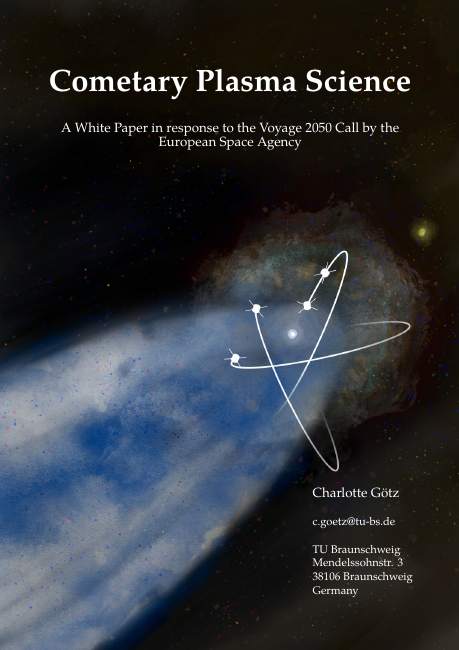Comets
White Paper on
Cometary Plasma Science
 The infant bow shock
The infant bow shock
The Rosetta spacecraft followed comet 67P/Churyumov-Gerasimenko for two
years, and this enabled observations of how the plasma boundaries developed
when the comet approached the Sun and the outgassing from the comet's
nucleus increased. A particularly interesting discovery was the infant bow
shock, which was observed by Rosetta. Bow shocks exists at all the planets
and at comets. Rosetta observed it about 50 times closer to the comet’s
nucleus than anticipated, because at 2-2.5 AU from the Sun it was being
formed. A bow shock in this state of development had never been seen before
anywhere in the solar system.
Read more about the infant bow shock in the
ESA news story or the
original publication.
Waves in the diamagnetic cavity
When a comet gets close to the Sun a diamagnetic cavity develops around the
nucleus. In this cavity the the magnetic field is much weaker than in the
surrounding plasma (less than 1 nT in the diamagnetic cavity of comet 67P,
when outside it can be 40 nT). One of the observations Rosetta made
was that ion acoustic waves, at frequencies up to 1.5 kHz,
appeared when the spacecraft entered the cavity and disappeared as soon
as it left.
Related publications
- "Ion acoustic waves near a
comet nucleus: Rosetta observations at comet
67P/Churyumov-Gerasimenko" by H. Gunell, C. Goetz, E. Odelstad,
A. Beth, M. Hamrin, P. Henri, F. L. Johansson, H. Nilsson, and
G. Stenberg Wieser, Annales Gepohysicae, vol. 39, 53-68, 2021,
doi:10.5194/angeo-39-53-2021.
- "The infant bow shock:
a new frontier at a weak activity comet" by
H. Gunell, C. Goetz, C. Simon Wedlund, J. Lindkvist,
M. Hamrin, H. Nilsson, K. LLera, A. Eriksson, and M. Holmström,
Astronomy & Astrophysics, vol. 619, L2, 2018,
doi:10.1051/0004-6361/201834225.
- "Energy conversion in cometary
atmospheres. Hybrid modeling of 67P/Churyumov-Gerasimenko " by
J. Lindkvist, M. Hamrin, H. Gunell, H. Nilsson, C. Simon Wedlund,
E. Kallio, I. Mann, T. Pitkänen, T. Karlsson
Astronomy & Astrophysics, vol. 616, A81, 2018,
doi:10.1051/0004-6361/201732353.
- "Plasma waves confined to the diamagnetic cavity of comet
67P/Churyumov-Gerasimenko" by
H. Gunell, C. Goetz, A. Eriksson, H. Nilsson, C. Simon Wedlund,
P. Henri, R. Maggiolo, M. Hamrin, J. De Keyser, M. Rubin,
G. Stenberg Wieser, G. Cessateur, F. Dhooghe, and A. Gibbons,
Monthly Notices of the Royal Astronomical Society,
vol. 469 (Suppl_2), S84-S92, 2017,
doi:10.1093/mnras/stx1134.
- "Ion acoustic waves at comet 67P/Churyumov-Gerasimenko.
Observations and computations" by
H. Gunell, H. Nilsson, M. Hamrin, A. Eriksson, E. Odelstad, R. Maggiolo,
P. Henri, X. Vallières, K. Altwegg, C.-Y. Tzou, M. Rubin, K.-H. Glassmeier,
G. Stenberg Wieser, C. Simon Wedlund, J. De Keyser, F. Dhooghe,
G. Cessateur, and A. Gibbons,
Astronomy & Astrophysics, vol. 600, A3, 2017,
doi:10.1051/0004-6361/201629801.
This article includes
supplementary material.
Updated 2021-01-30
